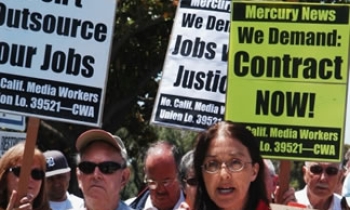NEW YORK (AdAge.com) -- As ink-and-paper publishers continue to struggle over how to maximize the Internet, The Wall Street Journal’s paid-access Web site is preparing another free "open house." The weeklong promotion is meant to attract new subscribers as well as lure advertisers into buying a day of dominance there -- for six-figure fees.
Web experiments
The promotion is approaching toward the end of a year that has seen plenty of experimentation, retrenchment and reversal among online publishers. Last month, The New York Times began charging Web surfers to read certain columnists. The move prompted complaints from bloggers and others, many of whom considered it a short-sighted attempt to prop up the dead-tree edition.
On the other side of the free vs. paid debate sits Time Warner’s AOL, which has re-created itself as a free portal and downplayed its monthly fee service. That strategy seems to have paid off in new interest from giants like Google, Yahoo and Microsoft Corp. in acquiring stakes in the company.
"The trend is towards opening up rather than closing down," said David Card, senior analyst, Jupiter Research. Free "open houses" for paid sites are a great idea, he added. "Our surveys about all kinds of paid content indicate that people who try a free trial are six times more likely to pay than those who don’t try a free trial."
Largest paid site
But The Journal’s Web site, after almost 10 years of operation, remains the envy of every print publisher struggling with a Web strategy. With about 764,000 subscribers, it is the largest paid-subscription news site online. Yearlong access costs $49 for print subscribers and $99 for nonsubscribers.
WSJ.com’s open house last year was a dry run of sorts. This year’s open house will run from Nov. 7-12.
"When the idea was originated, it was, This will be cool, to get more people exposed to it,’ " said Randy Kilgore, senior VP-advertising, Dow Jones Online. But the advertising group quickly realized that the extra visitors presented a premium-cost sponsorship opportunity, which it sold to companies like Intel and Nortel.
Now it has signed Charles Schwab, Chase Bank USA, Sprint Nextel and others to take turns with home-page takeovers (and ad dominance going three clicks deep) for the second open house. Non-paying Web surfers that arrive at the site during the promotion will see ads attributing their free access to each day’s sponsor.
Converting readers
Other Dow Jones properties, including Barron’s and the print version of The Journal, will run ads for the open house that credit the advertisers. But recruitment remains a primary goal. "It’s a very low-commitment way for readers to come in and see what’s there," said Todd Larsen, president-consumer electronic publishing. "Once we get people to try the site we know that we have a great opportunity to convert them."
The 2004 open house increased weekly unique visitors by about 90% and generated about 10,000 new subscriptions, according to Jennifer Stranzel, VP-marketing, consumer electronic publishing. And the demographics of those who arrived during the free week were consistent with other subscribers, she said.
Ms. Stranzel and the other executives declined to discuss what metrics they had set to measure the impact of this year's promotion.
Asked whether WSJ.com might begin to host more and more "open houses," where bigger traffic could be met with more-pricey advertising, Mr. Kilgore suggested that once a year might be enough. "There’s always a temptation to take a good thing too far," he said.
Mr. Card called the open house a "pretty good" experiment. "I don’t know what there conversion will be," he cautioned, however, "because it’s sort of an expensive property and people already know what it is."









